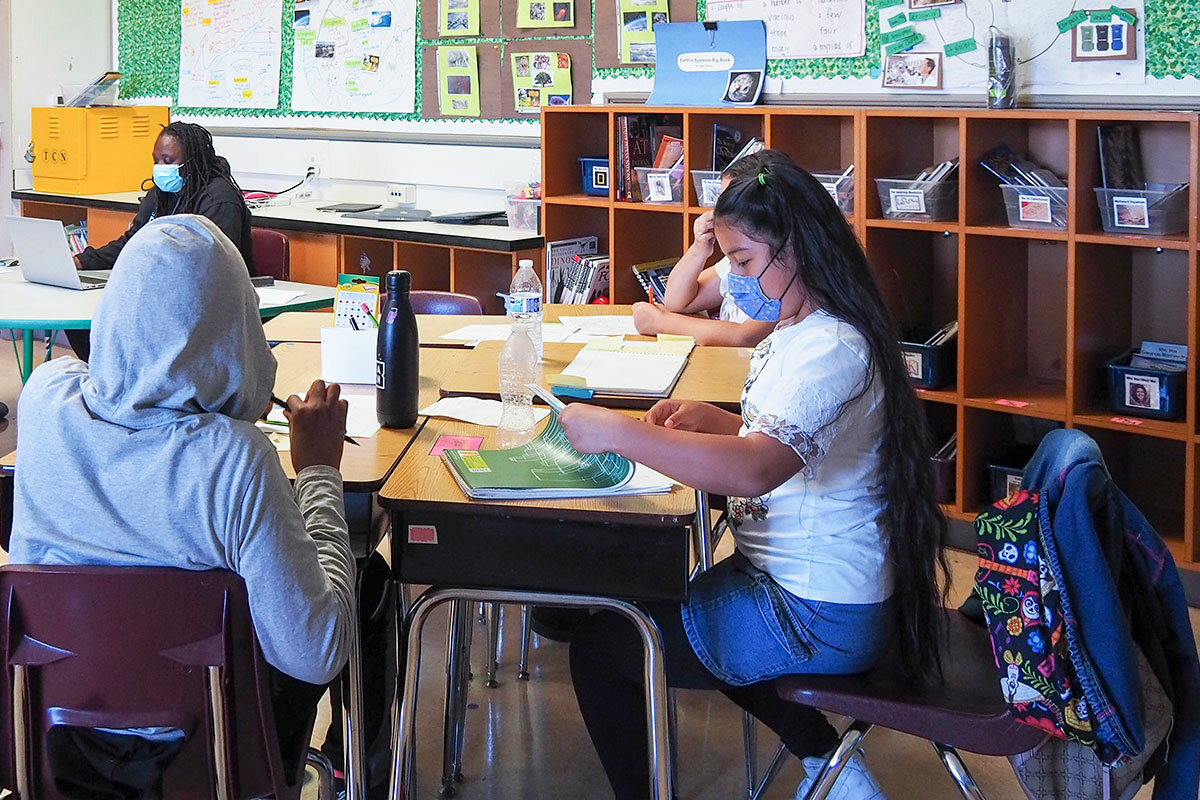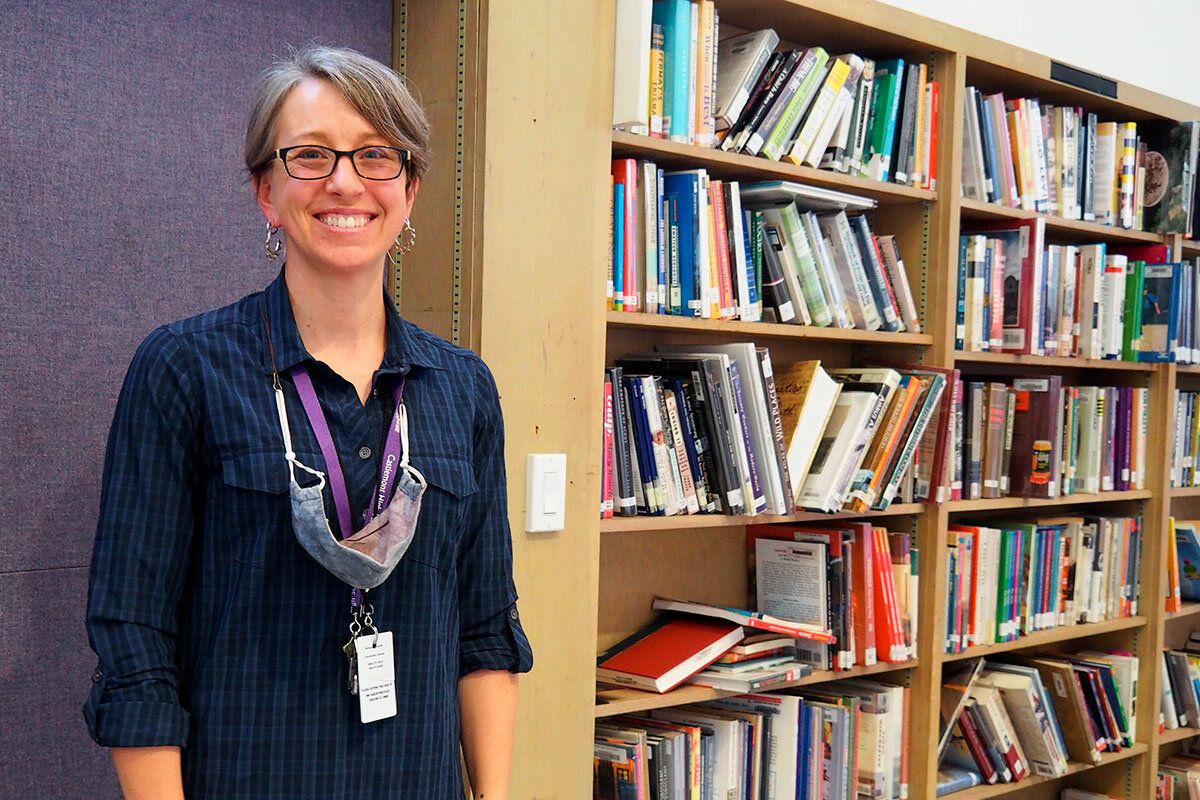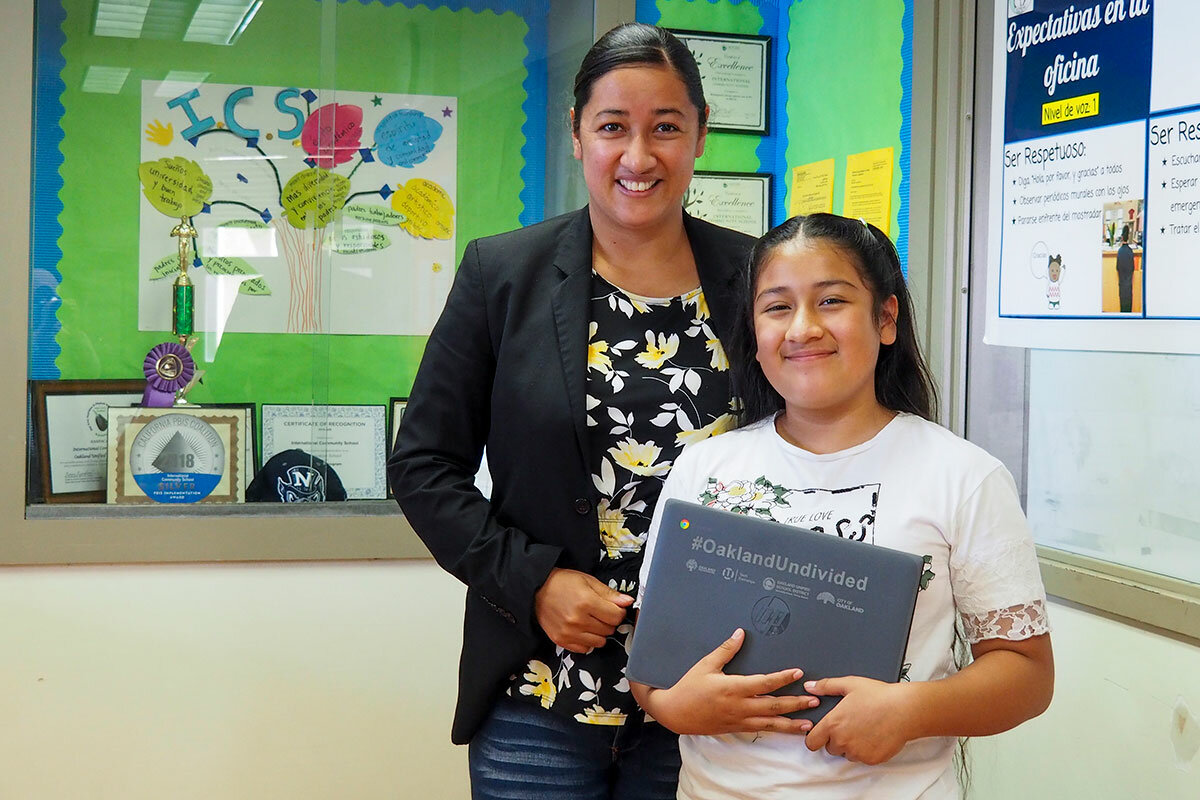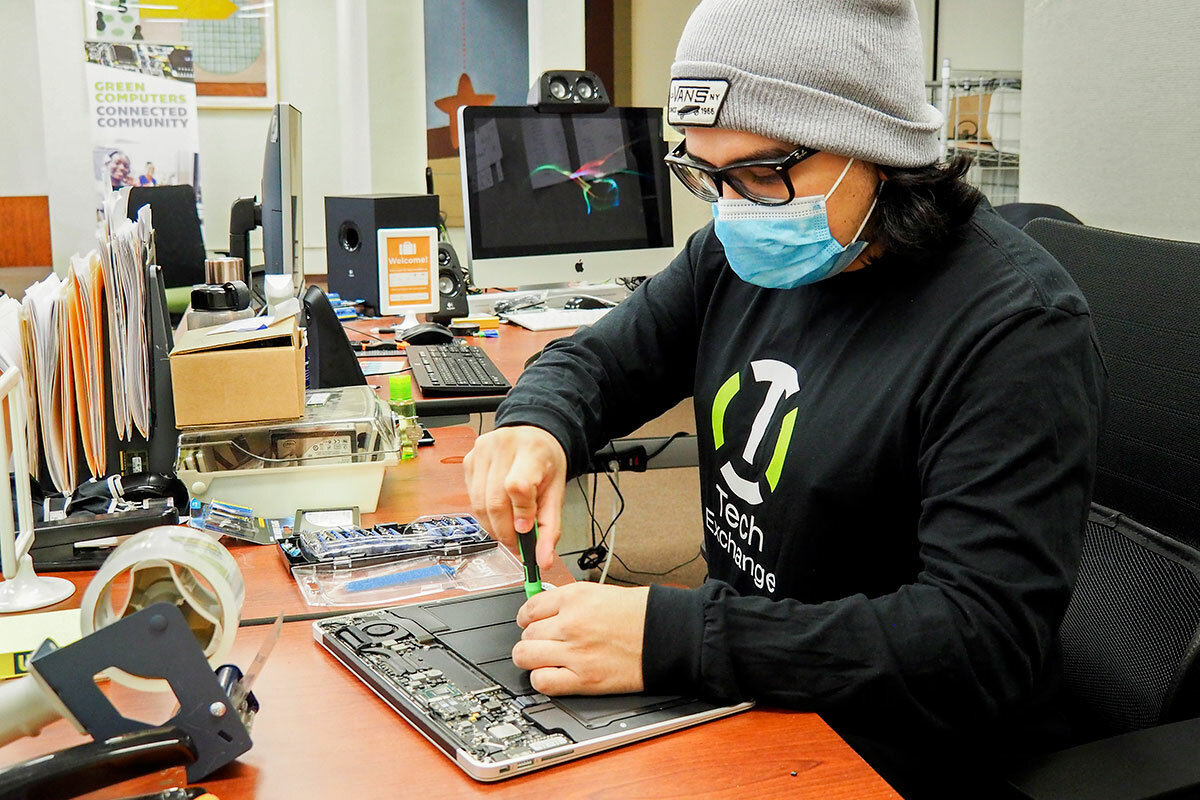How Oakland closed the digital divide for nearly all its students
Loading...
| OAKLAND, Calif.
After schools went remote in 2020, Jessica Ramos spent hours that spring and summer sitting on a bench in front of her local Oakland Public Library branch in the vibrant and diverse Dimond District. Ms. Ramos would connect to the library’s Wi-Fi – sometimes on her cellphone, sometimes using her family’s only laptop – to complete assignments and submit essays or tests for her classes at Skyline High School.
Ms. Ramos, used to texting quickly, was able to do simple assignments online, so at first her schoolwork was very easy. Then came the five-page papers for her two AP classes. “It was a hassle,” she says.
“We have this huge digital divide that’s making it hard for [students] to get their education,” she says.
Why We Wrote This
Recent success in closing the digital divide in Oakland, California, schools suggests what a partnership approach can achieve.
At the start of the pandemic, only 12% of low-income students, and 25% of all students, in Oakland’s public schools had devices at home and a strong internet connection. David Silver, the director of education for the mayor’s office, says people talked about the digital divide, but there had never been enough energy to tackle it. Once the pandemic hit, suddenly everyone was paying attention, says Mr. Silver, a former Oakland public school teacher and principal.
“You don’t have a computer, you don’t have internet, you can’t even access distance learning,” Mr. Silver says. “The 50,000 kids that are in Oakland public schools cannot actually go to school if they don’t have internet and computers. We need to change that.”
Now, two years into the pandemic, Oakland has been able to connect 98% of all students in the district. As of February, the city had provided nearly 36,000 laptops and more than 11,500 hot spots to low-income public school students. While some students remain unconnected, Oakland’s effort has emerged as an example of how to tackle a citywide digital divide.
“We were using the crisis as an opportunity to address a moral wrong that needs to be changed forever, not just during the pandemic,” Oakland Mayor Libby Schaaf says. “We can’t afford not to.”
City leaders, including Mayor Schaaf, say a partnership among the district, the mayor’s office, the Oakland Public Education Fund, the nonprofit Tech Exchange, Oakland Promise, and other community-based organizations is behind Oakland’s success. Oakland’s partnership, known as #OaklandUndivided, launched in May 2020. The ambitious goal: close the city’s digital divide for good by providing all K-12 public school students in Oakland with a computer they could keep, a reliable internet connection, and ongoing, multicultural tech support in languages families use.
“We [didn’t] want this to be a band-aid fix,” says Jordan Mickens, a Leadership for Educational Equity public policy fellow who served as #OaklandUndivided’s project manager until August 2021.
While most schools across the country are fully back in person, students continue to struggle to complete homework assignments or participate in remote learning because they lack adequate internet service and access to a computer at home – a phenomenon commonly referred to as the “homework gap.” According to a 2021 report from the think tank New America, 1 in 8 children from low-income families don’t have a computer at home, while 1 in 7 lack access to broadband internet.
“The homework gap isn’t new. It’s just been exacerbated by the pandemic,” says Rebeca Shackleford, the director of federal government relations at All4Ed, an education advocacy nonprofit. “There’s kids who sit in McDonald’s parking lots to be able to do their homework, and that’s pretty tragic.”
Technology as a lifeline
Before the pandemic, the digital divide was often considered a rural problem. But the chaotic effort to get students online during COVID-19 school closures made clear the issue affects Americans living in all kinds of places. A recent study from EducationSuperHighway, a nonprofit that works with school districts to help close the digital divide, found that affordability was the largest contributing factor.
Though only about 40 miles north of Silicon Valley, home to technology giants such as Google and Apple, Oakland was deeply underconnected when the pandemic shuttered its schools. When the Oakland Unified School District (OUSD) shut down, its 83 district-run schools and 33 charter schools served more than 49,000 students. Kyla Johnson-Trammell, Oakland’s superintendent, says the first couple of months of the pandemic were a scramble.
“It was all hands on deck. We piecemealed as much as we could in March and April 2020,” she says. Still, she added, there were “just so many stories of kids using their cellphones to complete assignments, to research, or having to figure out how to get to public libraries in order to access devices.”
The district handed out its existing stockpile of loaner devices and hot spots to as many students as possible, says Preston Thomas, OUSD’s chief systems and services officer.
Many of the devices were already four to five years old. Because the district had been under significant financial pressures for the five years prior to the pandemic, “we hadn’t really invested in our infrastructure around technology,” Mr. Thomas says.
Jen Bender is an instructional teacher leader and technology coordinator at Castlemont High School in a historically underresourced neighborhood in East Oakland. Helping the school with its technology needs had been only a small part of her job. Starting in April 2020, Ms. Bender stepped in as the school’s distance learning lead, and finding devices for students became her full-time role.
In the beginning, schools asked students to come get a device if they didn’t have one. But public transportation was disrupted as the state began to shelter in place, and some students and parents had no way to get to school. Other students’ family members were essential workers who couldn’t make it to school during the school day. The newcomers who didn’t speak English were the hardest to reach.
“We realized we had to start really targeting families,” Ms. Bender says. The district pulled in community workers who spoke Spanish and Mam, a Mayan language, and, she says, “had them make individual phone calls to families to get them to come in and pick up those devices.”
As May arrived, district administrators realized that relying on distance learning leads in each school to understand what was happening on the ground was insufficient, Mr. Thomas says. “We didn’t have a centralized way to track devices for students,” he says. “Like, we had no idea. Every school had their individual Google spreadsheet, and there wasn’t a unifying place where any of us could look.”
Meantime, Dr. Johnson-Trammell, the superintendent, and Mayor Schaaf had several conversations about how to tackle technology access and connectivity. As the pandemic unfolded, city officials also saw how deeply the lack of technology access impacted all of Oakland. Almost every resource and piece of information about COVID-19, including where to get food and how to apply for unemployment benefits, was being provided digitally.
“All the information was on the internet. And I imagined, for a minute, what a mother must feel like who didn’t have an internet connection or a computer,” Mayor Schaaf says. “It was so much bigger than just education. It was literally survival for Oakland families. Technology was the lifeline to information.”
“I think I got it! I think I got the computer.”
Mr. Mickens, who spent his first year as a teacher at Castlemont High School in 2014, jumped at the opportunity in June 2020 to run the new #OaklandUndivided initiative to close the digital divide.
The first thing the group did, Mr. Mickens says, was to start tracking the number of public school students who already had a device and internet service, and those who didn’t. By May 2021, the group had accounted for roughly 70% of all Oakland public school students through its Tech Check survey. Going in, the #OaklandUndivided team had anticipated about 25,000 students would need devices, internet, or both, based on the earlier school surveys and census data. The Tech Check survey “opened our eyes,” Mr. Mickens says.
Based on the survey results, #OaklandUndivided estimated that 75% of K-12 public school students, or almost 40,000, were either disconnected or underconnected, with inadequate internet access.
Meanwhile, the #OaklandUndivided leadership team, made up of staff employed by multiple agencies in the partnership, met weekly and launched a fundraising campaign with a goal of $12.5 million to provide the initial devices and hot spots. The campaign was able to bring in big donors like Twitter co-founder and then-CEO Jack Dorsey, who pledged $10 million to help meet the goal.
The campaign relied on Tech Exchange, an Oakland-based nonprofit that has been working on closing the city’s digital divide for more than two decades, to purchase devices and hot spots.
By March 16, 2021 – a year after school closures in Oakland – the partnership had handed out 25,000 Chromebooks to low-income students.
Mr. Mickens says distributing the devices – which students could keep permanently – was an experience he will never forget. When he taught at Castlemont in 2014, the school had only one Chromebook cart. “To go from that, to now giving every student their own computer … was incredible to be a part of,” he says.
The Oakland Reach, a parent-led advocacy group that works with underserved communities, joined the partnership along with several other community-based groups to reach more families.
Early in the pandemic, Bernadette Fenceroy, who has four children in Oakland public schools, relied on one loaner device and a hot spot that worked sporadically. No one got much learning done, she says.
“It is hard when you have some kids that are on the phone and you can’t get all your information,” Ms. Fenceroy says. When a child has a tutoring session, she notes, “You can’t do it on your phone and have to do it on a laptop or a desktop.”
Ms. Fenceroy took the Tech Check survey to see if her family qualified for free devices after hearing about it from Oakland Reach.
When she finally got the call in May 2021 saying her kids’ permanent laptops were ready to be picked up, she almost couldn’t believe it. She took a picture of the device and called her Oakland Reach contact: “I think I got it! I think I got the computer.”
Although her kids have devices now, Ms. Fenceroy hopes the district and #OaklandUndivided’s members don’t “just drop the ball,” she says. She wants them to stay in touch, make sure the devices are working, and let parents know who to call for help if they’re not.
An evolving approach
The #OaklandUndivided project has evolved since its inception. With an influx of federal funding available to schools in response to the pandemic, Oakland is using the opportunity to strengthen the program. The district received nearly $130 million from the Elementary and Secondary School Emergency Relief (ESSER) Fund, in addition to money from the Emergency Connectivity Fund (ECF), a federal program that has helped schools and libraries provide internet access and connected devices to students and educators during the pandemic.
But those federal funds come with parameters. All the #OaklandUndivided devices handed out in the early days of the pandemic were permanent gifts to families; officials say this was important because a district-managed device has restrictions on its use. A permanent device could be useful to parents trying to access online resources or pursuing their own educations, or it could follow a student on to college.
The federal ESSER and ECF programs require that any device purchased be owned by the school or the district. So, since Aug. 1, 2021, all the #OaklandUndivided devices going out have been loaners. While the district-lent devices will stay with the student for up to five years, the #OaklandUndivided initiative is still trying to keep its promise of providing permanent devices.
“Recognizing the importance of students owning a computer, we are working with Tech Exchange this year to distribute 4,800 refurbished computers to families who have no owned computer,” says Patrick Messac, the current #OaklandUndivided project manager.
The federal funding itself isn’t permanent. The ECF funding, which was originally set to expire this June, has recently been extended until June 30, 2023. The ESSER funds expire in 2024. Kyleigh Nevis, the devices and operations lead for #OaklandUndivided and OUSD, says the Oakland program is planning for the future and may, for example, switch students on hot-spot plans over to T-Mobile’s Project 10Million, a national program providing free internet to underserved student households.
As of January, the #OaklandUndivided team says, 35,960 families of public school students had received a Chromebook or hot spot or both. Two percent of low-income students remain unconnected.
For those still “missing,” the district has made a push this year to focus on what it calls high-priority students: those most at risk and with the greatest need, and whom the program still hasn’t been able to reach.
“We’re just trying to find creative solutions to reach these hardest-to-reach students,” Mr. Messac says. As of December, the district had surveyed 6,953 students and handed out an additional 5,835 Chromebooks.
Truancy remains one of the main barriers in reaching out to those missing students, Mr. Messac says. The Oakland district is also facing a financial crisis, and John Sasaki, director of communications for OUSD, says it plans to close two schools. Although #OaklandUndivided is a separate program run in partnership with the city that doesn’t rely entirely on funding from the district, the closings could complicate efforts down the road to reach out to students who aren’t connected yet. Mr. Messac says the program is working with the district to ensure that if students at the impacted school sites need digital access, those resources will be provided.
Ms. Ramos – now a freshman at the University of California, Berkeley, which provided her with a new laptop – sits on the #OaklandUndivided leadership committee. She wants other cities to use #OaklandUndivided’s model and expand on it to tackle the homework gap. The pandemic brought “a light to all these problems that need to be solved,” she says.
In November, EducationSuperHighway announced that Oakland was the inaugural pilot city for its nationwide initiative to close the affordability gap. In partnership with #OaklandUndivided, EducationSuperHighway is deploying free Wi-Fi in low-income apartment buildings.
“Oakland has done a terrific job creating a public-private partnership to connect their unconnected,” says Evan Marwell, EducationSuperHighway’s CEO. “That was really an effective thing for a lot of students. It hasn’t been a perfect solution, but was a best-in-class effort [from] around the country.”
This story about closing the digital divide was produced by The Hechinger Report, a nonprofit, independent news organization focused on inequality and innovation in education.









